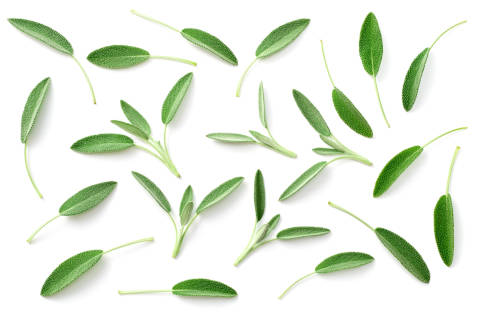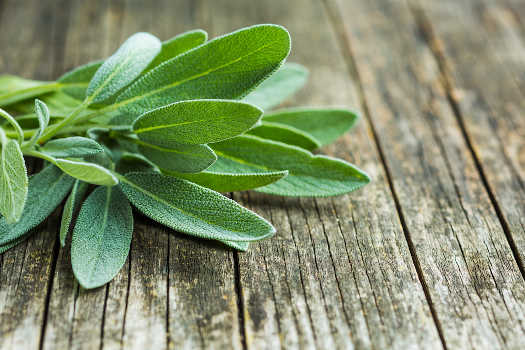White sage (Salvia apiana) is one of the new age movement’s most popular herbs. While a relative newcomer to European-based witchcraft, other varieties of sage have medicinal and magical traditions known to witches for ages.
Magical Properties of Sage
When discussing any properties of sage, it’s important to distinguish between species. White sage (Salvia apiana) is sometimes used as a cleansing and purification herb. To the people indigenous to white sage’s native habitat, it is an important sacred plant. For this reason, its use by witches is somewhat controversial.
One commonly-used European sage is garden or common sage (Salvia officinalis) is used for mental clarity, grounding, and wisdom. Some old kitchen witch recipes include it as a protective herb.
Whole sage leaves are also sometimes used for granting wishes — write a wish on a sage leaf, place it under your pillow for three days, then bury it in the yard. It is ruled by Jupiter, the Moon, and the elements of earth and air.
Clary sage (Salvia sclarea) is used for clarity, clairvoyance, psychic abilities, and to induce trance or visionary states. It is ruled by Mercury and the Moon, and the elements water and earth.
Benefits & Uses of Sage
Its spiritual attributes aside, white sage has numerous physical benefits as well. The leaves contain eucalyptol, one of the aromatic compounds in eucalyptus leaves.
When burned, white sage leaves may help relieve symptoms of sinus infections. Burning white sage has also been found to reduce airborne bacteria.
When brewed as a tea, white sage acts as an antibacterial and anti-inflammatory. It reduces joint pain and discomfort, and may help improve digestion.
Garden sage is a carminative, meaning that it can reduce or relieve gas in the intestines. It’s also used to reduce fevers and stop excess sweating.
Garden sage was one of the herbs supposedly included in Four Thieves’ Vinegar. This was a wine-based tincture that allegedly allowed four thieves in France to survive an epidemic of bubonic plague.
When steeped as a tea, garden sage has antibacterial properties. These work internally as well as externally — internally, it may help prevent or relieve foodborne illness. Externally, it can treat wounds or ulcers.

For those with type 2 diabetes, garden sage may help lower blood sugar. For people with irritable bowel syndrome, it can calm nerves in the stomach or intestines.
Clary sage has impressive anti-stress and anti-anxiety benefits. A 2010 study found that, of all essential oils tested, clary sage oil had the strongest anti-stress effect.
Another study in 2013 found that inhaling clary sage oil lowered stress levels and blood pressure in people undergoing medical testing.
One study involving rats found that clary sage extract had an anti-inflammatory effect.
Various studies have discovered that clary sage oil is effective against multiple species of bacteria, and may be an anti-fungal as well.
Traditionally, the seeds were used to clear debris from the eyes, since they’re small and rich in mucilage. When they encounter the wet environment of the eye, they form a gel that helps clear foreign objects — hence the herb’s alternative name, “clear eye.”
Possible Risks & Side Effects of Sage
It’s possible to be allergic to sage. These allergies can range from mild to severe, and may manifest as rashes, hay fever symptoms, indigestion, or full-blown anaphylactic shock. If you’re allergic to sage, please use an alternative.
Sage essential oil should never be taken internally.
Different sage species contain thujone. If you consume sage in tea form or use it as a supplement, avoid doing so for prolonged periods of time. Take regular breaks.
Because of sage’s thujone content, consuming it in excess can result in nervousness, restlessness, vomiting, tachycardia (rapid heart rate), dizziness, tremors, seizures, and damage to the kidneys.
Since garden sage has relaxant and blood sugar lowering properties, people currently taking anticonvulsant medications or medications to treat diabetes should consult their doctors before use. These medications may need to be adjusted.
Sage History & Folklore
Various sage species are so well-known as healing plants, that multiple European cultures have a saying: “Why die when there’s sage on the hill?” The name Salvia may even come from the Latin word meaning “to heal,” or “to save.” Another theory holds that the word comes from “to salve,” meaning to rub with an ointment.
Some physicians in the old world believed that consuming garden sage every day in May could lead to immortality.

Like rosemary, garden sage is believed to grow best in gardens where a woman rules the house.
Garden sage was sacred to Jove, and the Romans observed much ceremony while gathering it.
As mentioned above, white sage is a sacred plant to many Native American peoples. During the European colonialization, native religious practices — including the use of sage — were suppressed and severely punished. Out of respect for this, many modern witches prefer to leave white sage to the people who suffered for its use.
Getting Started With Sage
Most varieties of sage are easy to grow in the home garden. Kitchen witches, in particular, may wish to take a crack at growing garden sage.
It enjoys well-drained soil and lots of sun, and is generally winter hardy. White sage grows only in warm, arid regions, so most of the white sage on the market is wild harvested.
The easiest way to begin a relationship with garden sage is by including it in food. Hold a pinch of the fresh or dried herb, and envision it filling with energy. Speak your intention for the herb out loud. After adding it to a dish, stir the dish in a clockwise direction with a spoon held in your dominant hand.
Clary sage is easiest to use as an oil. Inhale it before divination, or add it to an anointing oil blend for prophetic dreams. If you wish, you can infuse dried clary sage in a neutral oil instead of using the essential oil.
As a genus, Salvia is regarded the world over as sacred and important. Whether its the white sage of North America, or the garden and clary sages of European witchcraft, these plants have been powerful magical and healing allies for as long as humans have been using herbs.
